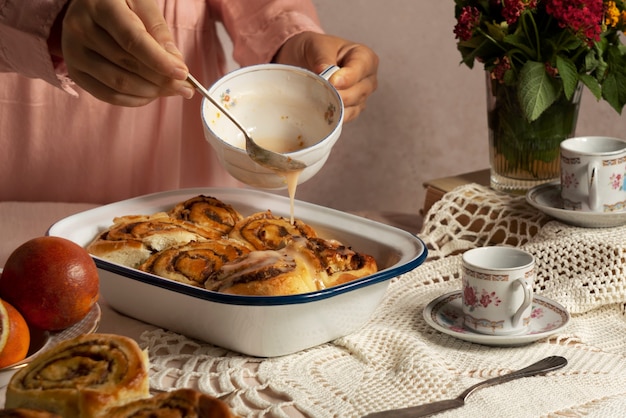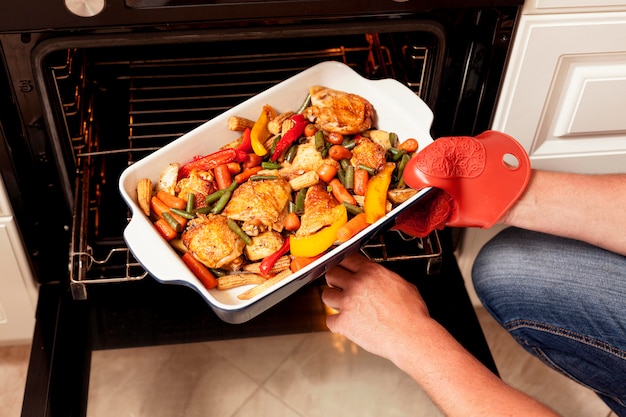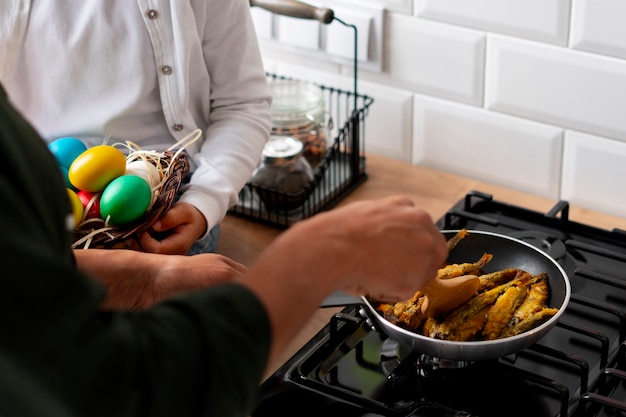Ah, stuffing. That glorious bread-based companion to a roast, often the star of the show for many a festive feast. But how long does it actually take to cook that perfect golden-brown, fluffy stuffing? It's a question that has plagued many a cook, myself included. As a seasoned home cook, I've experienced the highs and lows of stuffing preparation. I've had my fair share of victories, those perfectly cooked, crispy-edged masterpieces that disappear in a flash. But I've also had my moments of despair, when a dry, overcooked mess ended up in the bin. But fear not, my fellow food enthusiasts! I'm here to guide you through the world of stuffing oven times, and equip you with the knowledge to conquer even the most challenging stuffing situation.
(Part 1) The Stuffing Saga: A culinary journey

Let's be honest, stuffing is not your average dish. It's a bit of a wild card, a symphony of ingredients that can vary in texture, moisture, and flavor. Each recipe is a unique creation, a blend of bread, herbs, vegetables, and sometimes even sausage, all dancing together in a symphony of culinary delight. And then there's the oven. The humble oven, that magical box that transforms our raw ingredients into edible masterpieces. But when it comes to stuffing, the oven presents a whole new set of challenges.
The Roast Dilemma: Stuffing's Most Loyal Companion
When it comes to the oven, one question arises: do we cook the stuffing inside the roast, or do we give it a solo stint? For centuries, the traditional method has been to tuck the stuffing inside the cavity of a roast, like a turkey or a goose. It's a classic approach, one that infuses the stuffing with the delicious juices of the roast, creating a symphony of flavors. However, this method is not without its drawbacks. It can be tricky to monitor the stuffing's progress, especially when it's tucked away inside a large bird. You can't really peek inside and check for doneness without disrupting the delicate dance of the roast. This method requires a keen eye and a practiced hand. I've had my fair share of stuffing disasters using this method, and I wouldn't recommend it to anyone without a healthy dose of experience.
Independent Stuffing: A New Era of Control
My personal preference, and the method I advocate for, is to cook the stuffing separately in a baking dish. This approach allows for more control over the cooking process. You can check for doneness, monitor the browning, and adjust the oven time as needed. Plus, you get that glorious golden-brown crust on the top, a visual testament to the stuffing's deliciousness. It's a win-win situation, allowing you to achieve that perfect balance of crispy exterior and tender, flavorful interior.
(Part 2) Stuffing Oven Time: Unveiling the Secrets

Now, let's dive into the heart of the matter: the oven time. The golden rule for stuffing oven temperature is 350 degrees fahrenheit (175 degrees Celsius). This temperature is a happy medium, allowing the stuffing to cook through thoroughly without scorching the exterior. But here's the catch: the cooking time is anything but set in stone. It's a dynamic dance, influenced by a variety of factors.
The Variables: A Culinary Symphony
- The Type of Stuffing: A sausage stuffing, with its higher fat content, will cook faster than a classic bread-based stuffing. The fat helps to render and create a richer flavor, but it also means a shorter cooking time.
- The Size and Shape of Your Baking Dish: A smaller baking dish will mean a shorter cooking time, as the heat can reach the stuffing more quickly. A larger baking dish, on the other hand, will require a longer cooking time to ensure even cooking.
- Your Stuffing's Moisture Content: A wetter stuffing, with the addition of broth, stock, or moist vegetables, will take longer to cook than a dry one. The added liquid will need to evaporate, which requires additional time in the oven.
(Part 3) The Golden Rule: Doneness Unveiled

Forget about fixed times; focus on the signs of a perfectly cooked stuffing. It's a culinary masterpiece, a symphony of textures and flavors that should be a celebration of the senses.
- Golden Brown Crust: A sign that the stuffing has reached its peak, the golden brown crust is not just aesthetically pleasing, but also an indication that the exterior has achieved that perfect level of crispiness.
- Firm Texture: When you press on the stuffing, it should feel firm to the touch, not mushy or loose. This indicates that the stuffing has cooked through and is ready to be enjoyed.
- internal temperature: This is the most accurate way to determine doneness. Use a meat thermometer to check the internal temperature of the stuffing, ensuring it reaches 165 degrees Fahrenheit (74 degrees Celsius). This temperature ensures that any harmful bacteria are eliminated, ensuring a safe and delicious meal.
(Part 4) Let's Talk About Safety: A Culinary Priority
We've all heard the stories, the cautionary tales about undercooked stuffing and its potential consequences. It's a serious matter, a reminder that food safety is paramount in the kitchen. Stuffing is a prime candidate for bacterial growth, especially if it's not cooked thoroughly. Don't underestimate the importance of safety. Make sure the internal temperature of your stuffing reaches 165 degrees Fahrenheit to eliminate any harmful microorganisms. It's not worth the risk, especially when it comes to your health and the well-being of your loved ones.
(Part 5) The Art of the Check: Unveiling Doneness
Now, let's talk about how to check for that glorious doneness. You have a few options, each with its own charm and effectiveness.
- Meat Thermometer: Your trusted culinary ally, the meat thermometer is the gold standard for accuracy. Simply insert it into the thickest part of your stuffing and check the temperature. If it reads 165 degrees Fahrenheit, you're good to go.
- Wooden Skewer: If you're feeling adventurous, try using a wooden skewer. Insert it into the center of the stuffing and pull it out. If it comes out clean, your stuffing is ready. However, this method is not as accurate as using a thermometer, so it's best to use it in conjunction with other doneness indicators.
(Part 6) The Stuffing Equation: Timing Considerations
Let's talk about timing, shall we? The oven time for your stuffing can range from 30 minutes to an hour, depending on those factors I mentioned earlier. Here's a general guideline:
Stuffing Types and Oven Times
| Stuffing Type | Estimated Cooking Time |
|---|---|
| Bread-based stuffing | 45-60 minutes |
| Sausage stuffing | 30-45 minutes |
But remember, these are just estimations. Always check for doneness before serving.
(Part 7) Overcooked Stuffing: A Culinary Challenge?
Don't panic! Even seasoned cooks sometimes encounter the dreaded overcooked stuffing. It's not the end of the world, but it can be a bit of a bummer. Overcooked stuffing might be a bit dry, but it's still edible. The key is to add a bit of moisture back in.
- Extra Liquid: Add a little broth or gravy to your overcooked stuffing. It will help rehydrate it and bring back some of the lost moisture.
- Cover the Dish: Cover your baking dish with foil during the first part of the cooking time. This will help to prevent the top from drying out too quickly.
- Baking Dish with a Lid: A casserole dish with a lid can help to retain moisture, preventing the stuffing from drying out.
(Part 8) The Stuffing Saga Continues: A Culinary Journey of Exploration
And there you have it! A comprehensive guide to stuffing oven time at 350 degrees. The world of stuffing is a world of endless possibilities. It's a blank canvas for your culinary creativity. Feel free to experiment, customize your recipes, and find what works best for you. It's all about creating a dish that brings joy to your table and satisfies your taste buds.
(Part 9) Stuffing FAQs: Addressing Your Questions
Let's tackle some frequently asked questions about stuffing:
1. Can I reheat stuffing?
Absolutely! Reheating leftover stuffing is a breeze. You can reheat it in the oven, microwave, or on the stovetop. For the oven, heat it to 350 degrees Fahrenheit and bake for about 15-20 minutes, or until heated through. For the microwave, heat in 30-second increments, stirring in between. For the stovetop, heat it over low heat, stirring occasionally, until warmed through.
2. Can I freeze stuffing?
Yes, you can freeze cooked stuffing. Allow it to cool completely, then transfer it to an airtight container or freezer bag. It should stay good for up to 3 months in the freezer. When you're ready to use it, thaw it in the refrigerator overnight and reheat it according to the instructions above.
3. How do I make stuffing less dry?
There are a few ways to prevent your stuffing from drying out. As mentioned earlier, adding extra liquid, covering the dish with foil, or using a baking dish with a lid can help. You can also use a recipe that calls for more moist ingredients, such as apples, cranberries, or vegetables.
4. What are some good stuffing recipes?
The possibilities are endless! From classic bread-based stuffing to sausage stuffing to veggie-packed options, there's a recipe for everyone. If you're looking for inspiration, I recommend checking out online recipe websites or cookbooks. I'm particularly fond of a sausage and apple stuffing with a touch of sage. It's a perfect balance of savory and sweet.
5. What can I do with leftover stuffing?
Leftover stuffing is a culinary treasure! You can use it as a base for other dishes, like stuffing-stuffed peppers, stuffing-topped casseroles, or stuffing fritters. You can also add some chopped nuts and dried cranberries and use it as a topping for your favorite soup.
Remember, culinary mastery is a journey, not a destination. Keep experimenting, keep learning, and most importantly, keep enjoying the wonderful world of stuffing!
Everyone is watching

How to Cook Frozen Lobster Tails Perfectly: A Step-by-Step Guide
RecipesLobster. Just the word conjures up images of lavish meals, special occasions, and a taste of luxury. But let's...

Pigs in a Blanket Cooking Time: How Long to Bake for Perfect Results
RecipesAh, pigs in a blanket. Just the name conjures up images of those delightful little parcels of crispy pastry en...

Pork Fillet Cooking Time: How Long to Cook It Perfectly
RecipesPork fillet, or tenderloin as it's sometimes called, is a real favourite in our house. It's so versatile, and...

The Ultimate Guide to Tender, Juicy Pulled Pork
RecipesRight, let's talk pulled pork. It's one of those dishes that just screams "comfort food," doesn't it? I mean...

The Ultimate Guide to Cooking Sweet Potatoes: From Roasting to Mashing
RecipesSweet potatoes. Just the name conjures up images of warm, comforting dishes, bursts of vibrant color, and a to...
